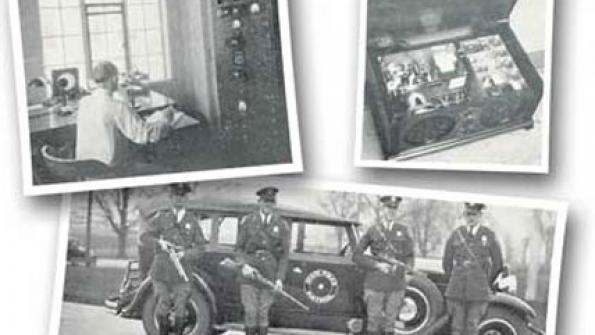In our century

In May 1928, The American City carried one of its earliest accounts of a police department using radios to communicate with officers in the field. The brief article described a system St. Louis had devised in which the police chief could directly alert a local public radio station of a major crime, and news of the crime would be broadcast over the airwaves — to the public as well as police in squad cars. The model was repeated by other cities, including Chicago, according to a report in the May 1929 edition that announced that all squad cars of the Chicago Police Department Detective Division were equipped with radio receiving sets. Chicago’s early one-way radio system was supported by the Chicago Tribune, which operated station WGN. The newspaper installed a direct telephone from the Police Dispatch Section to its station and would broadcast crime news by “cutting in” on regular programs.
The technology proved useful in reducing the amount of time it took to dispatch officers to crime scenes, and by August 1930, St. Louis had installed its own transmitting station that could send messages to receiver-equipped squad cars and police stations using a different frequency than the public radio stations. Roy Glasgow, radio engineer for the St. Louis Metropolitan Police Department wrote, “There seems to be good evidence that the knowledge of the speed and effectiveness of the police radio system is discouraging a number of the criminally minded, causing them to curtail their activities to an appreciable extent.”
By October 1930, the Michigan State Police had built an addition to its headquarters to house a radio transmitter by the DeForest Radio Co., of Passaic, N.J., and radio receivers were furnished to each sheriff and state police facility and installed in many police cars. Oscar Olander, commissioner of police, wrote that the value of the radio system was in apprehending criminals more quickly. In 1929, for instance, a man wanted by the FBI for participating in the Chicago St. Valentine’s massacre killed a patrolman during a traffic stop and fled. “In this, as in other cases which might be cited, the men would not have escaped if our radio station had been in operation.”
Previous “In our century” Stories
-
In our century — December 1913
Cities adopt the city manager form of government to improve administration and bring efficiency to operations -
In our century — October 1913
Cities take action in the earliest days of motion pictures to regulate content and ensure theater safety -
In our century — July 1935
Cities install parking meters in business districts to improve traffic flow, reduce car damage and generate revenue -
In our century — April 1910
Cities organize July Fourth events, regulate fireworks to reduce Independence Day injuries and deaths -
In our century — May 1915
Cities seize revenue-generating opportunities to provide ice and refrigeration to residents and businesses -
In our century — May 1914
Officials invest in maps to guide public projects, improve city administration and communicate plans to the public -
In our century — September 1915
Technology develops to ensure the safe movement of trains, cars and emergency vehicles through city streets -
In our century — July 1914
Among the early efforts to improve public health, cities invent and seek weapons of mass fly destruction -
In our century — August 1913
When bond issues fail, cities seek alternative funding for infrastructure improvements and other public projects -
In our century — August 1914
Cities improve cleanliness and public health by strategically placing public restrooms and encouraging their use -
In our century — December 1914
Cities begin the tradition of decorating enormous public Christmas trees to celebrate the holidays -
In our century — June 1910
Government accounting methods and reports mature from vague and incomplete records to standard formats. -
In our century — October 1909
Investigations into corruption and mismanagement lead to (some) reforms in government policies and operations. -
In our century — January 1913
Cities experiment with road surfaces and set out methods for funding road construction and maintenance. -
In our century — September 1909
Limits on outdoor advertising are set through cities’ hard-fought battles over billboard sizes, messages and locations. -
In our century — August 1911
Fire departments gain authority, modern equipment to prevent and improve response times to structure fires. -
In our century — June 1910
Street lights become symbols of communities’ economic success, and lighting technology efficiency evolves. -
In our century — September 1909
With urban growth comes city leaders’ desire to control and direct it for the community’s greatest benefit. -
In our century — September 1909
Cities embrace playgrounds as valuable public assets for children’s safety, health and social development. -
In our century — September 1909
Women embrace public causes, work to improve their communities and expand their societal roles. -
In our century — March 1910
Cities develop methods, mechanisms and regulations for residential solid waste collection and disposal. -
In our century — November 1909
Occupancy laws and social workers emerge in the early 1900s to clean up inner-city neighborhoods. -
The way we were
Publisher’s son remembers American City & County‘s roots.




















